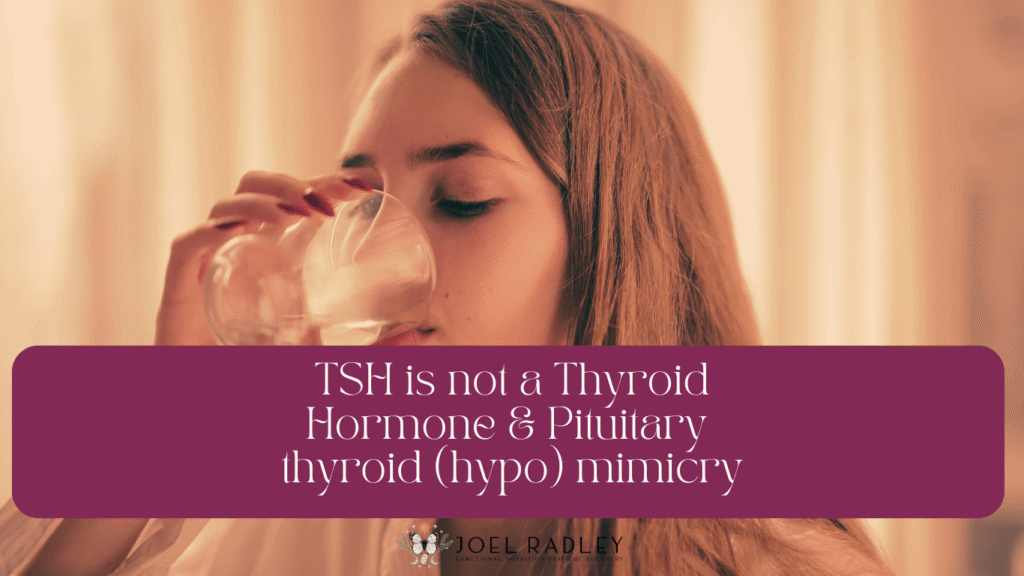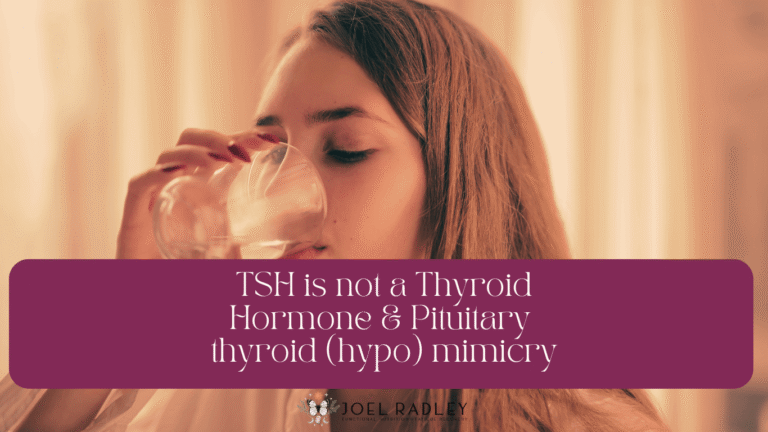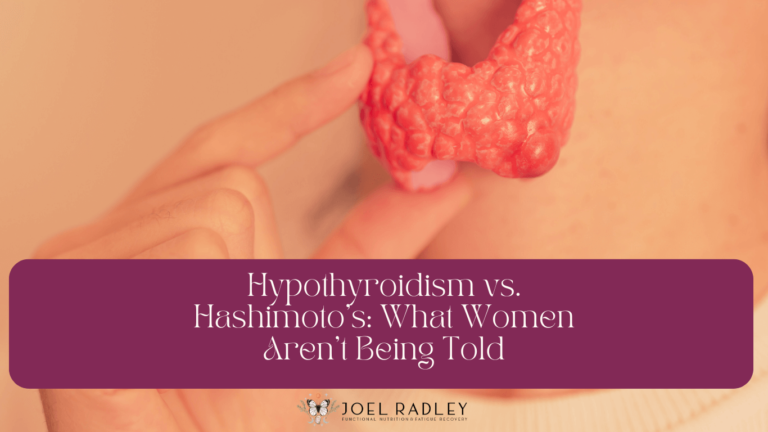Table of Contents
The Endocrine Triangle: Pituitary, Thyroid & Systemic Integration
There are four primary endocrine glands orchestrating hormonal balance: the adrenals, gonads (ovaries or testes), thyroid, and pituitary thyroid. The pituitary sits at the apex of this triangle, acting as the conductor between the hypothalamus and the rest of the endocrine system.
Understanding the relationship between the pituitary thyroid and overall health is crucial for effective treatment.
Its job is to constantly monitor, adjust, and maintain internal balance (homeostasis). It tells the thyroid when to release hormones, the adrenals when to manage stress, and the gonads when to cycle or produce sex hormones. But when the pituitary is dysregulated, the entire network starts to fail, often showing up as chronic fatigue, stubborn weight gain, poor sleep, brain fog, anxiety, and the tell-tale “pregnancy bloat belly” or “fatigue face” that so many women recognize but doctors dismiss.
The HPT Axis: How the Pituitary Talks to the Thyroid
The interplay between the pituitary thyroid and other hormones can significantly impact your well-being.
The hypothalamic-pituitary-thyroid (HPT) axis functions like a feedback loop. The hypothalamus releases TRH (thyrotropin-releasing hormone) which tells the pituitary to release TSH (thyroid-stimulating hormone). TSH then signals the thyroid gland to produce T4 (thyroxine) and T3 (triiodothyronine), the hormones responsible for metabolic rate, energy, digestion, mood, and temperature.
When T3 and T4 levels drop, the pituitary senses this and increases TSH output to “wake up” the thyroid. When thyroid hormones rise, TSH drops again, this is the negative feedback loop.
The problem is that when the pituitary or hypothalamus is under stress, inflamed, or mineral-deficient, this loop stops functioning correctly. The thyroid may still be capable, but it’s not being signalled properly. This is where central (secondary) hypothyroidism begins.
Recognizing the symptoms linked to the pituitary thyroid can lead to better management of thyroid disorders.
Why TSH Isn’t Always a Reliable Marker
TSH isn’t actually a thyroid hormone at all, it’s a pituitary hormone. That means when the pituitary gland is struggling, your TSH might look “normal” or even slightly high, while your thyroid hormones (T4 and T3) are low.
Addressing issues with the pituitary thyroid can lead to improved health outcomes and quality of life.
Doctors often rely solely on TSH to diagnose thyroid disorders, missing the fact that your pituitary may be the issue. In this scenario, you’ll still feel all the typical symptoms of low thyroid: waking up unrested even after 8 hours of sleep, unexplained weight gain, bloating after meals, thinning outer eyebrows, puffy eyelids, cold hands and feet, slow digestion, low mood, and the drained, swollen “fatigue face” that tells your body’s metabolism is off..
A comprehensive approach that includes the pituitary thyroid is essential for effective treatment.
Moreover, the connection between stress and the pituitary thyroid is vital for understanding hormonal balance.
Evaluating the role of the pituitary thyroid in your symptoms can help refine your treatment plan.
The Pituitary–Adrenal Connection
The pituitary doesn’t act alone. It receives constant messages from the hypothalamus and works hand-in-hand with the adrenal glands. Chronic emotional or physical stress forces the pituitary to prioritise cortisol production (your survival hormone), which often comes at the expense of thyroid function and reproductive hormones.
When stress becomes chronic, your pituitary shifts its signalling, down-regulating TSH and thyroid output to conserve energy. Over time, this creates a metabolic “slowdown” that mimics hypothyroidism, even when your thyroid gland itself is healthy.
Why T4 Medication Doesn’t Alway
It’s important to note how the pituitary thyroid functions within the broader context of the endocrine system.
Many people are prescribed synthetic T4 (levothyroxine) under the assumption that low T4 automatically means thyroid failure. But if your pituitary is under-signalling, or if your adrenals are overstressed, the feedback loop is already broken.
In this situation, flooding the body with T4 can backfire. The system becomes overwhelmed, and instead of efficiently converting T4 to T3 (the active hormone), it converts it into reverse T3 (rT3), an inactive form that blocks thyroid receptor sites.
Over time, you can end up with too much T4, rising rT3, and worsening hypo symptoms such as fatigue, sluggish metabolism, dry skin, low libido, depression, hair loss, constipation, and that unshakable sense of exhaustion no matter how much you sleep.
This is why so many people feel worse or see no improvement on T4 medication alone, the problem isn’t always the thyroid gland, it’s the feedback loop and pituitary regulation.
A better remedy involves supporting adrenal health, stabilizing the nervous system, and rehabilitating the pituitary so it can resume proper signaling.
Root-Cause Triggers of Pituitary Dysfunction
Pituitary dysfunction can arise from multiple layers of stress, physical, emotional, biochemical, and environmental. Some of the most common contributors include:
Inflammation and oxidative stress: Chronic inflammation from infections, food sensitivities, or toxins can disrupt hypothalamic and pituitary signalling.
Mineral imbalance: Low magnesium, copper, and sodium relative to potassium can blunt pituitary response and distort TSH output. This is where Root Cause Protocol (RCP) principles help rebuild mineral intelligence and restore communication across the endocrine triangle.
Fluoride exposure: Fluoride in tap water has been shown to accumulate in the pituitary and pineal glands. It can raise TSH levels artificially and impair T4-T3 conversion, mimicking or worsening hypothyroid symptoms. Filtering your water or choosing high-quality mineral water such as San Pellegrino, Gerolsteiner, or local spring sources can make a tangible difference.
Chronic stress and trauma: Emotional or physiological stress reduces hypothalamic TRH release, dampening pituitary function and flattening your hormonal rhythm.
Low energy metabolism: When cellular energy is low, pituitary cells lose their ability to respond to hypothalamic signals. This energy deficit often goes hand-in-hand with adrenal fatigue, low retinol, and liver sluggishness, all common in thyroid clients.
Ultimately, maintaining a healthy pituitary thyroid balance is a cornerstone of endocrine health.
How to Support the Pituitary and Restore Balance
1. Support adrenal function to stabilise sodium-potassium balance
Your adrenals depend on stable electrolytes and minerals. This helps regulate blood pressure, energy, and pituitary-adrenal communication. Salt your food liberally with unrefined sea salt, replenish magnesium through topical or ionic forms, and ensure whole-food potassium intake through fruit, coconut water, or mineral broths.
2. Prioritise deep rest and nervous system repair
When you wake up exhausted, it’s not laziness, it’s a dysregulated HPA (hypothalamic-pituitary-adrenal) axis. Techniques like slow breathing, EFT tapping, bodywork, and gentle circadian alignment can restore parasympathetic tone and relieve pituitary burden.
3. Feed the thyroid-pituitary connection
Retinol (active vitamin A), balanced minerals, B vitamins support thyroid receptor sensitivity and pituitary feedback. Iron and magnesium must also be balanced correctly to allow energy metabolism to function efficiently.
4. Filter your water and protect the glands
Avoid fluoride-contaminated water. Install a reverse osmosis filter or opt for mineral water rich in bicarbonates and trace elements. These minerals directly feed the pituitary and adrenal glands, helping recalibrate hormonal signalling.
5. Address the emotional root
Pituitary dysfunction often correlates with long-term suppression, feeling responsible for everyone, carrying pressure quietly. Restoring hormonal flow means restoring self-permission to rest, delegate, and recover.
Final word
f your thyroid labs look fine but you still feel exhausted, bloated, and foggy, the problem may not be your thyroid at all. It may be your pituitary struggling to keep up.
Understanding the Endocrine Triangle changes everything. The thyroid doesn’t act alone. It listens to the pituitary, which listens to the hypothalamus, which listens to your stress, mineral status, and energy balance.
By supporting the pituitary with minerals, adrenal restoration, and nervous system regulation, you can help your thyroid finally respond, often needing less medication, less guesswork, and seeing more consistent energy, digestion, and mental clarity.
SEO Keywords: pituitary dysfunction hypothyroidism, endocrine triangle, HPT axis, SPA axis, Root Cause Protocol, central hypothyroidism, T4 medication not working, reverse T3, fluoride pituitary gland, adrenal thyroid connection, functional nutrition thyroid fatigueIf you’re ready to get out of the fog of medications with lousy results, unbearable side effects like thinning hair, low energy and weight issues, into a functional healing plan that actually works, reach out and let’s find what your body’s been missing. Reach out via messaging me, and I’ll send you my free “Test Your Thyroid at Home” guide and share how we can work together 1:1 to restore your thyroid, gut, and energy, for good.
Warmly,
Joel










